 A pedestrian walking on a street that's been designed for people with disabilities
A pedestrian walking on a street that's been designed for people with disabilities
This blog commemorates the International Day of Persons with Disabilities held every December 3rd.
Investment in inclusive infrastructure is an aspect of economic development that demands our urgent attention. With an estimated 1 in 6 (or 1.3 billion) people experiencing significant disability—80% of whom live in developing countries—it is essential to consider how to make urban centers more accessible in the planning, financing, and building stages.
Disability inclusion has evolved from being seen as a charitable endeavor to a recognized development issue, led by organizations for persons with disabilities and supported by donors, including Australia, Canada, Japan, Norway, the United Kingdom, the United States, and institutions like the World Bank and Asian Development Bank. The United Nations also plays a crucial role in promoting the rights and inclusion of persons with disabilities, primarily through the UN Convention on the Rights of Persons with Disabilities (UNCRPD) and the Sustainable Development Goals (SDGs), including SDG 11 on making cities more inclusive, safe, and sustainable.
How Japan promotes inclusive urban infrastructure
Japan’s cities are known to be among the world’s most accessible in terms of the built environment and public services. A phased approach to urbanization that began in the post-World War II era has today yielded a model that prioritizes economic growth as well as sustainable living. This is particularly evident in the city of Toyama, where city planners recognized that taking an integrated approach to urban and transport planning was vital to preserving the city’s economic efficiency and that considering total life-cycle costs for infrastructure was necessary.
Japan's commitment to inclusive infrastructure, championed by the Japan International Cooperation Agency (JICA), extends to gender equity and disability inclusion . JICA promotes quality infrastructure and has established comprehensive guidelines and the JICA Global Agenda for Social Security / Disability and Development for every stage of infrastructure projects. Its approach encompasses detailed planning, implementation, monitoring, and evaluation, with the involvement of its Social Security team, to ensure that each project is meticulously reviewed for inclusivity—thus enhancing the scope and impact of disability inclusion in global infrastructure development.
The Dhaka Mass Transport system exemplifies JICA’s principles by including dedicated areas on metro cars for people in wheelchairs and the inclusion of female operators, illustrating how infrastructure can be functional and inclusive, and a model for future projects worldwide.
Working together on inclusive infrastructure
Despite the growing recognition of its importance, implementing inclusive infrastructure, also known as universal design, is not without challenges. These include policy and regulatory barriers, funding constraints, and the need for specialized knowledge in inclusive design. Overcoming inclusive infrastructure challenges requires a collaborative effort from governments, the private sector, civil society, international organizations, and representative advocacy organizations.
The World Bank employs a three-pronged strategy to enhance disability inclusion, comprising technical assistance, knowledge leadership, and partnership building, with Japan as a key collaborator.
To illustrate this, recently, a partnership between the Quality Infrastructure Investment (QII) Partnership and Tokyo Development Learning Center (TDLC), both initiatives of the government of Japan and the World Bank, co-organized a half-day public seminar in Tokyo, dedicated to sharing Japanese knowledge and experience around the criticality of financing universal design.

Additionally, the Maputo Urban Mobility Project is a good example of how the QII Partnership is incorporating the QII Principles, including Principle 5 on integrating social considerations in infrastructure investment in World Bank infrastructure projects. Together, the QII Principles help governments ensure that infrastructure projects contribute to sustainable, resilient, and inclusive growth. By leveraging big data to map mobility patterns across income groups in developing Maputo’s first bus rapid transit system, the system is designed to be accessible for low-income groups and to maximize private sector participation, showcasing a commitment to inclusive and sustainable urban transportation solutions.
Japan and the World Bank also collaborate in infrastructure development through the Global Infrastructure Facility (GIF).
More investment in and work towards full inclusion will be necessary to create a built environment where everyone, including people with disabilities, can thrive.
The authors participated in a knowledge event dedicated to the importance of financing universal design held in Tokyo on October 16, 2023, organized by the Tokyo Development Learning Center and the QII Partnership. Watch the event on YouTube here.
Related:
Disability Inclusion and Accountability Framework
How digital public infrastructure supports empowerment, inclusion, and resilience
#IDPD 2021: Addressing psychosocial disabilities in the conflict-affected deep South of Thailand
Community-Driven City Planning with the Yokohama City sketch Workshop
Why is the “quality” of infrastructure investment essential for building back better?




Join the Conversation